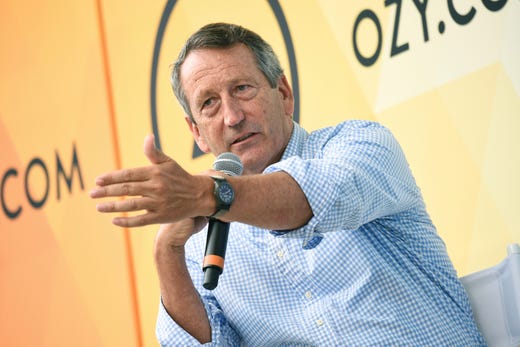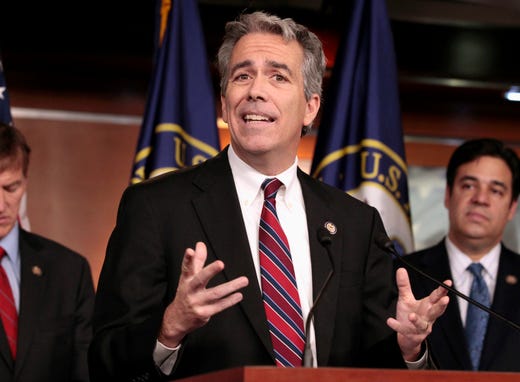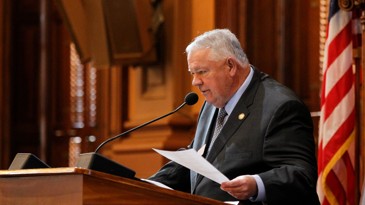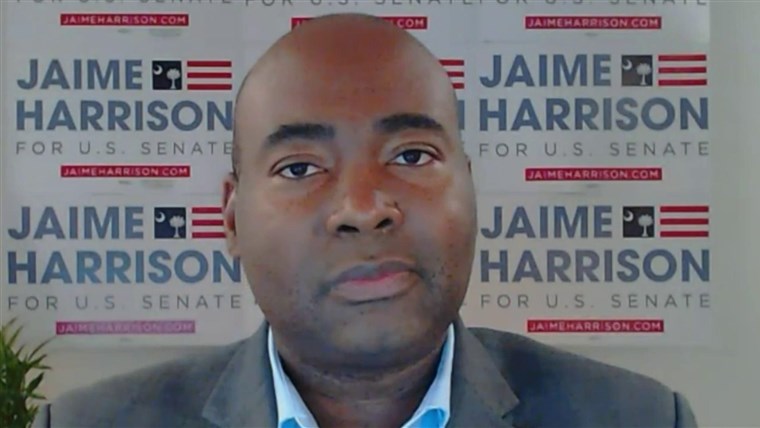Democratic activists in swing districts knock on doors in attempts to turn the elusive Obama-to-Trump voter back to the Dems. USA TODAY
CONNECTCOMMENTEMAILMORE
STEVENS POINT, Wis.— Two Democratic activists in this swing district knocked on the door to the home of one of the big white whales of the 2020 election cycle: The elusive Obama-to-Trump voter.
Hayley Bird, a canvasser from the local College Democrats club, introduced herself and asked the voter a neutrally-worded question: “What’s the most important issue we’re facing as a state or country?”
“He’s psychotic,” responded 68-year-old Alvin White, referring to President Donald Trump. He then told Bird he voted for Trump in 2016 after twice casting ballots for Obama.
White grumbled that he was embarrassed by the president’s attempt to buy Greenland, insistence on building a wall on the U.S.-Mexico border, and frequent provocative rhetoric to the news media and on Twitter.
But when Bird’s fellow canvasser Joan Garski asked White to rate Trump on a scale of 1 (awful) to 10 (awesome), the retiree was more charitable.
“I would give him a 5,” said White, who added he was leaning toward voting for former Vice President Joe Biden in 2020 if he wins the Democratic nomination but was less enthusiastic about the rest of the field. “I got to give Trump credit — the job market is doing pretty good.”
The Iowa caucuses that will kick off the Democratic nomination fight are still more than three months away.
But already top Democratic Party officials are looking down the road and shaping their strategy to win back voters like White in the general election. In the process, they’re posing a bigger question that’s pivotal no matter who they nominate: What will it take to beat Trump in November 2020?
Four states in particular — Florida, Michigan, Pennsylvania and Wisconsin — are seen as among the most pivotal for Democrats to move back into their column. Trump carried all four in 2016 by a combined margin of less than 200,000 votes after Barack Obama won all of them in both 2008 and 2012.
And Democrats also are dealing with a new dynamic in the race after House Speaker Nancy Pelosi launched an impeachment inquiry of Trump over allegations that he abused his power by pressing Ukraine to investigate Biden, one of his top political rivals, and the former vice president’s son, Hunter Biden. Trump has insisted he did nothing improper.
USA TODAY interviewed more than two dozen Democratic National Committee officials, county Democratic chairpersons, elected officials and rank-and-file activists in Florida, Michigan, Pennsylvania and Wisconsin about the path to victory. They highlighted an increased effort on the ground in early states, a desire to make the message to voters more issue-driven, and warned against ignoring voters who may have been overlooked in 2016.
Here is how they think the Democrats can win.
Developing a robust ground game
The old adage “it comes down to turnout” is cliché — but true. And to drive turnout, you have to have people on the ground, making contact with voters.
DNC officials say they have identified seven battleground states — Arizona, Florida, Georgia, Michigan, North Carolina, Pennsylvania and Wisconsin — that Trump won in 2016 for special focus. The party is in the midst of hiring 1,000 organizers across those states to try to turn the tide.
The DNC has also purchased nearly 7 million voter cell phone numbers in Pennsylvania and Wisconsin as they attempt to bolster data bases and reach more voters in those key states, officials said.
And after a falloff in black voter participation in 2016, the DNC has put an early emphasis on voter outreach in communities of color. That includes a multi-million dollar investment by the DNC and progressive partners to recruit, pay and train young voter outreach workers in black and Latino communities in places like Milwaukee and Philadelphia, where minority turnout is key to Democrats’ hopes of winning Wisconsin and Pennsylvania.
In Michigan, Trump won by nearly 11,000 votes in 2016, marking the first time a Republican presidential nominee took the state since George H.W. Bush in 1988.
“I will own the party’s part in falling short in 2016,” said Lavora Barnes, the Michigan Democratic Party chairwoman. “What we did not do is prepare ourselves to run a ground game. We sat back and waited for the national campaign — waited for the nominee to be chosen and then tried to stand up a campaign right around the time of the convention. It was too late. We have vowed as a party that that will never let this happen to us again.”
When talking to voters, Brian Kerrigan, chairman of the Marquette County Democratic Committee, said activists and candidates need to stay focused on bread-and-butter issues where Trump has fallen short — including failure to get an infrastructure deal, slow wage growth and trade wars that have complicated business for farmers and manufacturers in the Rust Belt.
He and elected Democrats throughout the sprawling 100-square mile county in the Upper Peninsula of Michigan have begun to hold listening tours to ask voters what issues are most important to them, with the intent of filtering up that information to state Democrats and eventually the national party.
Former Secretary of State Hillary Clinton took Marquette County by four points in 2016 but won about 2,000 fewer votes than Obama did in 2012. If activists can help the 2020 Democratic nominee pick up even a few hundred votes more than Clinton did, it could prove to be significant in changing the fate of Michigan in 2020, Kerrigan said.
Ronald Reagan posed to voters in his successful 1980 run against Jimmy Carter: Are you better off than four years ago? How the electorate has answered that question has largely determined whether incumbent presidents since the 40th president have been ultimately successful in winning reelection.
Kerrigan countered that Trump’s booming economy has not helped many working-class Americans. “The better question is, ‘Where do we want to go in our communities, in our state and in the country,’” he said.
More: Who is running for president in 2020? An interactive guide
Trump, for his part, has attempted to keep the spotlight on a strong economy. Unemployment is hovering near 50 year low and the economy grew by a solid 2.5% last year, but still short of the 3% growth Trump promised with his push for tax cuts and deregulation.
Trump has lashed out at Pelosi over the impeachment inquiry and slammed the opposing party as “do nothing Democrats” pursuing impeachment because they fear running against him on the issue of the economy.
He’ll have a huge war chest to make his pitch to voters.
The Republican National Committee announced it jointly raised $125 million with the Trump reelection campaign in the third quarter of this year alone. Trump broke precedent by starting to fundraise for his reelection immediately after his 2017 inauguration.
“When you have the president announce his reelect early and when you have the RNC chairwoman (Ronna McDaniel) raising record amounts of money every single month,” said Rick Gorka, the RNC’s communication director for battleground states, it allows you to reinvest more into the data and the ground game.”
Opinion: Trump raids military families, national security to pay for border wall: Vets in Congress
It can’t be just about Trump
While pointing out where Democrats believe Trump has failed may resonate with some voters, voters and activists also said candidates need to talk about more than just the president.
To varying degrees, top-tier Democratic candidates have sought to flip the script and define Trump as a candidate who may have been good for the rich but bad for workers, the environment, women and minorities.
South Bend, Indiana, Mayor Pete Buttigieg has repeatedly warned on the campaign trail that every time Democrats are talking about Trump, they’re missing an opportunity to talk about the lives of voters.
Biden — who in recent days has found himself spending a fair amount of energy pushing back against Trump’s unsubstantiated allegations of misdeeds in Ukraine by him and his son — has centered his campaign as an attempt restore “the soul of this country,” to bolster the middle class and to unify the nation.
Elizabeth Warren, the first major Democratic candidate to call for Trump’s impeachment, has told voters they need to demand their elected officials are doing more than talking about their differences with Trump. The election of the president in 2016 was a symptom of a greater illness, she’s argued.
“This dark moment requires more than being ‘not Trump’, because a country that elects someone like Donald Trump is a country that’s already in serious trouble,” Warren said in a speech at last month’s Massachusetts Democratic Convention.
As Bird and Garski canvassed in Stevens Point on the recent afternoon, they heard less outrage from voters about the president and more anxiety about whether Trump — and politicians in Washington writ large — are in tune with what’s keeping average Americans up at night.
One voter, John Strassburg, told the canvassers he was concerned about states tightening voter identification rules — creating roadblocks for many Americans, particularly minorities and low-income people, who want to cast their ballots. “Before anything else we have to improve voter registration laws,” he said.
Kody Lutz told Garski and Bird he was concerned about the trickle-down effect of Trump’s trade war with China on Wisconsin businesses and his livelihood.
He works at one of 11 railroad companies that operate in the state and he’s anxious as railway traffic has slowed down. Total U.S. carload traffic for the first nine months of 2019 was down 3.8% from the same period last year, according to the American Association Railroads. The railroad group says the slowdown is due in part to trade uncertainty.
“People at work have been talking about layoffs,” Lutz told Garski and Bird.
Gary Stark, chairman of the Kent County Democratic Party in western Michigan, said the eventual nominee needs to remind voters about the failures of the Trump administration and spend less energy on outrage over the president’s bluster, misstatements and lies.
“In his victory he speech, he said he was going to be president of all the country, we know where that’s gone,” Stark said. “Things like reminding voters that he said Mexico is going to pay for the wall, I think, might have more traction. We should remind voters of the trade war and the impact it’s having on things, the impact of the trade war on farmers, the impact of his failure of action on health care. I think if we stay focused on what his failed promises are doing to average people it will have more impact voters.”
Come to voters where they are
Bert Sise, Democratic County chairwoman in Monroe County, Fla., recently had an older acquaintance and once-staunch Trump backer approach her to tell her he’s finally had it with Trump.
The last straw was the administration’s decision to postpone more than 100 Pentagon projects — including nine schools for troops’ children and repairs to military facilities damaged by hurricanes in Puerto Rico — so the president could divert about $3.6 billion to his long sought after border wall.
“I’ve made some conversions, as I like to call them,” Sise said. “For some of them, the scales are dropping from their eyes, but not enough in my estimation. There are still those who think he can do no wrong, and they say if he does wrong, they say, ‘Who cares?’”
But at the same time, Sise said that Trump has been a “great recruiter for the Democratic party.”
In her county that includes the Florida Keys — an area Obama took by about five percentage points in 2008 but Trump won by 7 points in 2016 — Sise said there are signs that Democrats can turn things around.
Her committee’s meetings — Democrats hold three meetings a month in the different parts of the sprawling county — used to attract only about 10 people but now regularly attract dozens.
Sise, 71, who spent more than 30 years managing a truck terminal, said she feels some optimism for Democrats, because Trump “steps on his (penis) every day” and demonstrates a penchant for offending huge parts of the electorate.
“Democrats and the nominee need to remember: Don’t talk down to people,” she said. “I think Hillary had a problem with that. The nominee needs to be genuine, and find a way to show them how our policies relate to them. And on the ground game, we need to make sure we train our people to make the argument without getting into a pissing contest.”
Vaughn Derderian, the Oakland County, Michigan, Democratic Party chairman, said Democrats too often suffer from a measure of arrogance that “because our ideas are better, we will win.”
The 2018 midterms offer Democrats a measure of confidence about their chances of turning the state blue in again 2020.
Gov. Gretchen Whitmer, a Democrat, cruised to victory, winning by more than 400,000 votes. The party also flipped two Republican-held U.S. House seats. And incumbent Sen. Debbie Stabenow’s margin of victory was more than 4 points higher in Michigan counties that Clinton won in 2016 than the presidential nominee. Meanwhile, her Republican opponent’s margin of victory in Trump counties was nearly 9 percentage less.
But Derderian thinks about his own overconfidence in a state House race he worked on in 2018. The day before the 2018 midterms, Derderian sat in the living room of his candidate reviewing early her voting metrics that suggested his candidate should take the race. The next day, his candidate lost.
“I think we have to always be looking in the rearview mirror,” Derderian said. “No matter how comfortably we think we should be able to win, we should spend everyday thinking that we’re on the edge of losing.”
Badger State Poll: Fox News poll shows Trump nine points behind Biden in Wisconsin, a key swing state
Monster GOP haul: Trump campaign, RNC to report record $125 million third quarter fundraising haul
Be careful who you ignore
In places like Dauphin County, Pennsylvania, and Seminole County, Fla., Democratic officials say the electorate offers a near perfect mirror of the United State population as a whole, but place like these get short shrift from Democratic candidates.
Dauphin, which includes the state capital of Harrisburg, is by many measures the statistically closest to resembling American as a whole, according a study the Washington-based political research firm Echelon Insight.
The county went for Clinton by 2.9 percentage points, while the popular vote margin in the country as a whole was 2.1 points. The median household income is $54,968, just off the national average of $57,805. Just more than 29% of adults over 25 graduated from college, compared to the national average of 30.3%. At 47.8%, the percentage of the population that belonged to a religious congregation in 2010 is very close to the national average of 48.8%, the Echelon study notes.
“My advice to candidates is take notice of all of Pennsylvania and just don’t spend all your time in Philadelphia,” said Rogette Harris, the Dauphin County Democratic Committee chairwoman.
Brittany Nethers, the Democratic committee chairwoman in central Florida’s Seminole County, said that whoever is the party’s presidential nomination would do well by following the lead of 2018 gubernatorial candidate Andrew Gillum and his approach in her neck of the woods.
The county, which includes the growing suburbs north of Orlando, was once solidly Republican but Democrats have made headway as the area has become more diverse. The county ranked as the seventh most representative of the U.S. as a whole in the Echelon study.
Trump took Seminole County by 1.5 percentage points in 2016, while the GOP nominee in 2012, Mitt Romney, took the county by more than six percentage points.
Gillum, the former Tallahassee, Fla., mayor, managed to win the county by two percentage points in the 2018 gubernatorial race in which he narrowly lost the state to Rep. Ron DeSantis. In 2014, then-Republican Gov. Rick Scott won the county by more than seven percentage points.
“Having the candidates come to these areas — not just the main cities — would be vital to help drum up support for whoever is the nominee,” Nethers said. “We saw it with Andrew Gillum, who made three or four stops here, and it ultimately helped him.”
Daniel Henry, Democratic committee chairman for Duval County in Northern Florida, said that in the early going, both state and national Democratic officials are taking a different tact and recognizing that there are votes to be won in areas like his — one that has historically favored Republicans but has become a voter-rich battleground for Democrats in recent cycles.
For example, state Democrats during the 2014 election only assigned two or three field organizers at a time to the county, which includes the city of Jacksonville and for decades had long trended Republican, Henry said.
In 2016, Clinton’s campaign had only a small presence in the county before her campaign and Democrats built up presence months before Election Day. She ended up losing the county by about 1.4 percentage points.
But by the 2018 election cycle, the state party had assigned 15-to-18 field organizers at time assigned to the Jacksonville area. (Republicans won the gubernatorial race in the county by more than 12 percentage points in 2014, but Gillum took the county by more than four percentage points in 2018 race.)
“The difference I see is there is a recognition (by state and national Democratic party leaders) that in order for them to get the vote margin they need, they must increase output in all urban areas,” Henry said. “Jacksonville has a unique history of being a location in Florida that has a large African American voters. If you’re going to win statewide in Florida, you have to get a large number of African American voters to actually show.”
Whoever wins the nomination will certainly need to make a marked improvement from Clinton’s showing with black voters in 2016. At 59.6%, the 2016 black turnout was the lowest rate since 2000 and about six points behind that of the white turnout rate.
Harris, the Dauphin County Democratic chairwoman, recalled raising concerns to a Pennsylvania state party leader about Democrats needing to do better job at embracing diversity — including candidates making certain that their campaign teams look like America. The leader, she recalled, responded, “Well, you don’t have anywhere to go.”
“You can’t have that attitude,” Harris said. “You can’t take any vote for granted. People might not vote for Trump, but they can stay home.”
Don’t repeat Clinton’s mistakes
In central Wisconsin, Garski, a longtime Democratic activist, made her first 2020 canvass more than nine months earlier than the last election cycle.
Clinton in her post-campaign memoir, “What Happened,” acknowledged that “if there’s one place where we were caught by surprise, it was Wisconsin,” saying that polls showed her ahead until the end. She skipped campaigning in Wisconsin and instead relied on surrogates to blanket the state.
As Garski knocked on doors in Stevens Point, she recalled the disappointment of 2016 and says the loss still gnaws at her. Portage County had been a reliably Democratic stronghold — Obama won it by about 28 points in 2008 and nearly 14 points in 2012. Clinton took the area by less than 4 points in 2016.
From conversations she’s had with friends and neighbors following the 2016 election, Garski says it is clear to her that Democrats’ failure to reunite after a hard-fought primary battle between Clinton and Sen. Bernie Sanders played a big part in Trump’s victory.
Too many Sanders voters, who thought the nomination process unfairly favored establishment candidates like Clinton, sat out the general election or even voted instead for Trump or Green Party candidate Jill Stein, she said. Sanders won the 2016 Democratic primary in Wisconsin.
The DNC has taken steps to underscore the importance of Wisconsin — which awards 10 delegates — by selecting Milwaukee to host the party’s nominating convention.
The DNC also dialed back the importance of superdelegates, unpledged Democratic officials and party activist who choose for themselves whom they vote for at the convention. In 2020, superdelegates will be excluded unless no candidate wins a majority of the delegates on the first ballot at the national convention.
Garski said she’s trying to remain optimistic that Democrats will close ranks behind whoever the nominee is and won’t see a repeat of 2016 in key states like hers.
“I am hopeful, but you just never know,” Garski said.
After several hours of canvassing on the recent afternoon in Stevens Point, Garski raced to catch the tail-end of the “Fighting” Bob Fest, a gathering of progressive Democrats to honor the rabble-rousing grandfather of the state’s progressive politics, Robert La Follette.
She arrived to catch the festival’s closing session in which two of the state’s more liberal lawmakers, state Sen. Jeff Smith and state Rep. Katrina Shankland, argued that Democratic candidates can win up and down the ballot by focusing on health care, education, wage growth and repairing the state and nation’s crumbling infrastructure.
“All paths lead to Wisconsin and through Wisconsin, and Wisconsin, we have the opportunity to send our electoral votes to a strong progressive,” Shankland told the gathering. “The path to a better White House, the path to a better Congress, to a better assembly runs across districts like this.”
But as the festival wound down, one attendee told Shankland and Smith that she couldn’t stomach casting a vote for the bulk of the Democratic field — most notably Biden — who she said haven’t demonstrated that they “are good for my people.”
“A $15 minimum wage is good for my people, getting Medicare for All is good for my people,” said Lenore Hitchler, 71, a retired nanny and Sanders supporter who said she would support Sanders or Warren in 2020 but would not commit to the rest of the field. “I want the Democratic party to know that even though I’m a member of the party, they don’t have my vote locked up.”
CONNECTCOMMENTEMAILMORE
Read or Share this story: https://www.usatoday.com/story/news/politics/elections/2019/10/14/2020-election-how-do-democrats-beat-trump/3899108002/



 1 of 23
1 of 23 2 of 23
2 of 23 3 of 23
3 of 23 4 of 23
4 of 23 5 of 23
5 of 23 6 of 23
6 of 23 7 of 23
7 of 23 8 of 23
8 of 23 9 of 23
9 of 23 10 of 23
10 of 23 11 of 23
11 of 23 12 of 23
12 of 23 13 of 23
13 of 23 14 of 23
14 of 23 15 of 23
15 of 23 16 of 23
16 of 23 17 of 23
17 of 23 18 of 23
18 of 23 19 of 23
19 of 23 20 of 23
20 of 23 21 of 23
21 of 23 22 of 23
22 of 23 23 of 23
23 of 23

